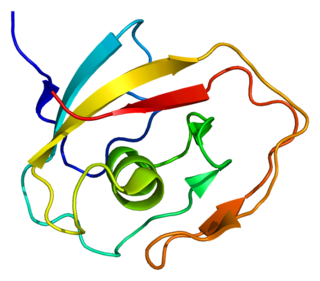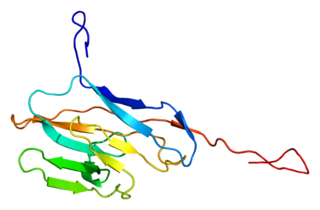Related Research Articles

Carcinoembryonic antigen (CEA) describes a set of highly-related glycoproteins involved in cell adhesion. CEA is normally produced in gastrointestinal tissue during fetal development, but the production stops before birth. Consequently, CEA is usually present at very low levels in the blood of healthy adults. However, the serum levels are raised in some types of cancer, which means that it can be used as a tumor marker in clinical tests. Serum levels can also be elevated in heavy smokers.

Collagen alpha-2(XI) chain is a protein that in humans is encoded by the COL11A2 gene.
Collagen IV is a type of collagen found primarily in the basal lamina. The collagen IV C4 domain at the C-terminus is not removed in post-translational processing, and the fibers link head-to-head, rather than in parallel. Also, collagen IV lacks the regular glycine in every third residue necessary for the tight, collagen helix. This makes the overall arrangement more sloppy with kinks. These two features cause the collagen to form in a sheet, the form of the basal lamina. Collagen IV is the more common usage, as opposed to the older terminology of "type-IV collagen". Collagen IV exists in all metazoan phyla, to whom they served as an evolutionary stepping stone to multicellularity.

Myosin-9 also known as myosin, heavy chain 9, non-muscle or non-muscle myosin heavy chain IIa (NMMHC-IIA) is a protein which in humans is encoded by the MYH9 gene.

Carcinoembryonic antigen-related cell adhesion molecule 1 (CEACAM1) also known as CD66a, is a human glycoprotein, and a member of the carcinoembryonic antigen (CEA) gene family.

Wolframin is a protein that in humans is encoded by the WFS1 gene.

Carcinoembryonic antigen-related cell adhesion molecule 6 (CEACAM6) also known as CD66c, is a member of the carcinoembryonic antigen (CEA) gene family..

Cochlin is a protein that in humans is encoded by the COCH gene. It is an extracellular matrix (ECM) protein highly abundant in the cochlea and vestibule of the inner ear, constituting the major non-collagen component of the ECM of the inner ear. The protein is highly conserved in human, mouse, and chicken, showing 94% and 79% amino acid identity of human to mouse and chicken sequences, respectively.

Gap junction beta-3 protein (GJB3), also known as connexin 31 (Cx31) — is a protein that in humans is encoded by the GJB3 gene.

Potassium voltage-gated channel subfamily KQT member 4, also known as voltage-gated potassium channel subunit Kv7.4, is a protein that in humans is encoded by the KCNQ4 gene.

Carcinoembryonic antigen-related cell adhesion molecule 3 (CEACAM3) also known as CD66d, is a member of the carcinoembryonic antigen (CEA) gene family..

Alpha-tectorin is a protein that in humans is encoded by the TECTA gene.

Myosin-14 is a protein that in humans is encoded by the MYH14 gene.

Carcinoembryonic antigen-related cell adhesion molecule 8 (CEACAM8) also known as CD66b, is a member of the carcinoembryonic antigen (CEA) gene family. Its main function is cell adhesion, cell migration, and pathogen binding.

Eyes absent homolog 4 is a protein that in humans is encoded by the EYA4 gene.

Carcinoembryonic antigen-related cell adhesion molecule 7 is a protein that in humans is encoded by the CEACAM7 gene.

Carcinoembryonic antigen-related cell adhesion molecule 5 (CEACAM5) also known as CD66e, is a member of the carcinoembryonic antigen (CEA) gene family.

Retinal degeneration is a retinopathy which consists in the deterioration of the retina caused by the progressive death of its cells. There are several reasons for retinal degeneration, including artery or vein occlusion, diabetic retinopathy, R.L.F./R.O.P., or disease. These may present in many different ways such as impaired vision, night blindness, retinal detachment, light sensitivity, tunnel vision, and loss of peripheral vision to total loss of vision. Of the retinal degenerative diseases retinitis pigmentosa (RP) is a very important example.

Espin, also known as autosomal recessive deafness type 36 protein or ectoplasmic specialization protein, is a protein that in humans is encoded by the ESPN gene. Espin is a microfilament binding protein.

Wolfram-like syndrome is a rare autosomal dominant genetic disorder that shares some of the features shown by those affected with the autosomal recessive Wolfram syndrome. It is a type of WFS1-related disorder.
References
- ↑ Kammerer R, Rüttiger L, Riesenberg R, Schäuble C, Krupar R, Kamp A, et al. (June 2012). "Loss of mammal-specific tectorial membrane component carcinoembryonic antigen cell adhesion molecule 16 (CEACAM16) leads to hearing impairment at low and high frequencies". The Journal of Biological Chemistry. 287 (26): 21584–21598. doi: 10.1074/jbc.M111.320481 . PMC 3381124 . PMID 22544735.
- ↑ Zheng J, Miller KK, Yang T, Hildebrand MS, Shearer AE, DeLuca AP, et al. (March 2011). "Carcinoembryonic antigen-related cell adhesion molecule 16 interacts with alpha-tectorin and is mutated in autosomal dominant hearing loss (DFNA4)". Proceedings of the National Academy of Sciences of the United States of America. 108 (10): 4218–4223. Bibcode:2011PNAS..108.4218Z. doi: 10.1073/pnas.1005842108 . PMC 3054008 . PMID 21368133.
- ↑ Hofrichter MA, Nanda I, Gräf J, Schröder J, Shehata-Dieler W, Vona B, Haaf T (October 2015). "A Novel de novo Mutation in CEACAM16 Associated with Postlingual Hearing Impairment". Molecular Syndromology. 6 (4): 156–163. doi:10.1159/000439576. PMC 4662267 . PMID 26648831.